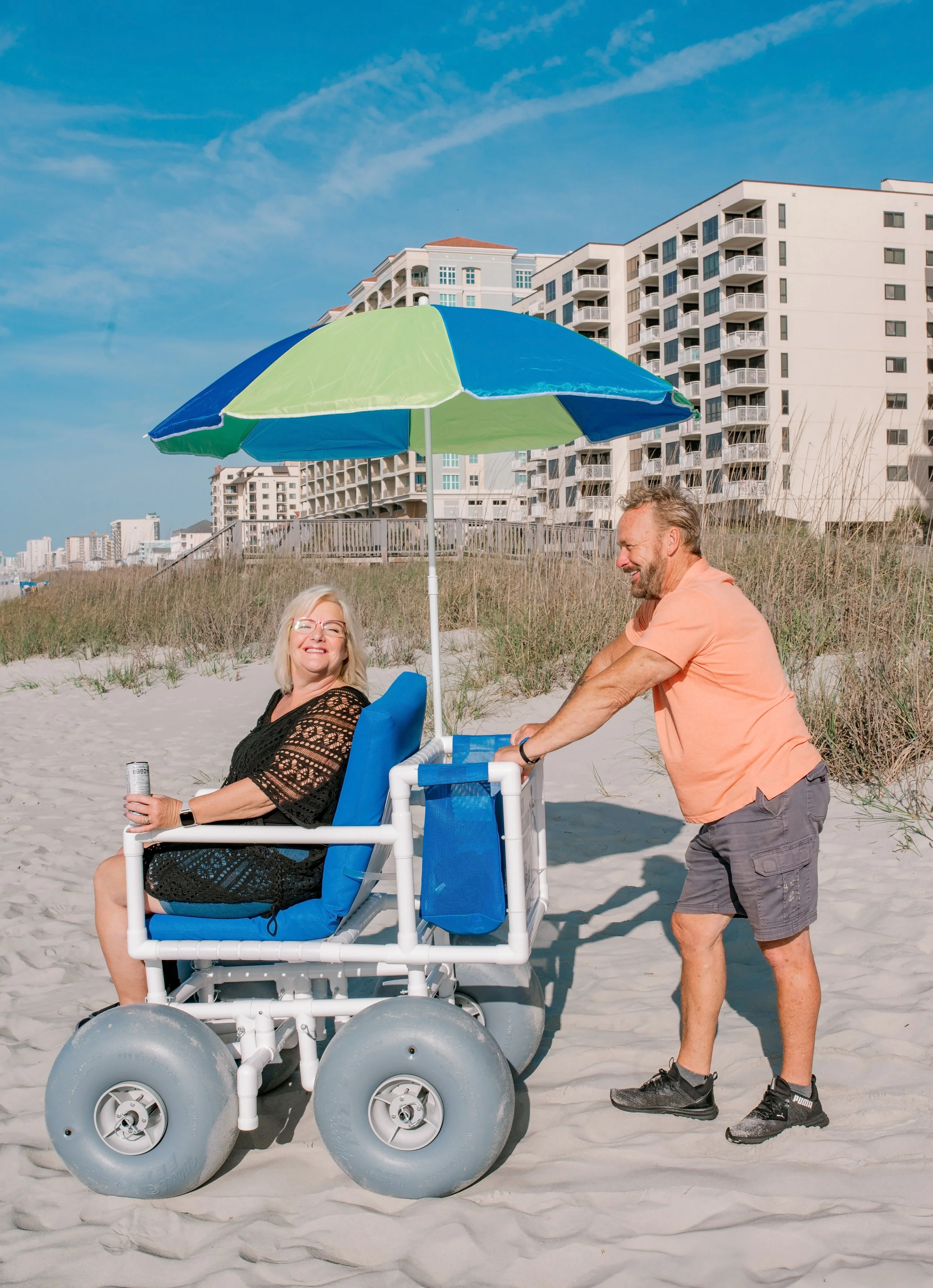Mastering Mobility on Sand: A Comprehensive Guide to Beach Wheelchair Maneuverability
Sand-Friendly Wheelchairs
Navigating sandy beaches in a wheelchair can be challenging, but with the right techniques and a specially designed beach wheelchair, enjoying the beach is now easier than ever. This blog explores the unique features of beach wheelchairs and provides practical tips to maximize maneuverability on the sandy beaches of Myrtle Beach.
Understanding Beach Wheelchairs
Beach wheelchairs are engineered to handle environments that standard wheelchairs cannot. Unlike traditional models, beach wheelchairs typically feature larger, wider wheels that distribute weight more evenly and prevent sinking into soft sand. These wheels, often referred to as balloon tires, are pivotal for smooth movement across the beach.
Key Feature: Balloon Tires Balloon tires are significantly larger than standard wheelchair tires and are made from soft, pliable materials. Their broad surface area and lower pressure allow them to float over sand rather than plowing through it. You can learn more about the design and functionality of balloon tires here.
The Science of Polyurethane Balloon Tires
Polyurethane is a versatile polymer that is widely used in everything from furniture and footwear to industrial machines and automotive components. In the context of beach wheelchairs, polyurethane is particularly valued for its ability to combine the elasticity of rubber with the toughness and durability of metal.
Features of Polyurethane Tires:
Durability: Polyurethane is resistant to puncture and abrasion, which is crucial for navigating over rough and uneven beach surfaces.
Flexibility: Despite their toughness, these tires are incredibly flexible, which allows them to adapt to the contours of the sand without sinking.
Low Pressure: The tires are designed to operate at lower pressure than traditional tires, increasing their footprint on the sand. This disperses the weight of the chair and its occupant over a broader area, reducing the risk of the wheelchair getting stuck.
These properties make polyurethane an ideal material for the balloon tires used on beach wheelchairs, enabling smoother rides over challenging terrains like sand.
Effective Maneuvering Techniques
Mastering the Art of Maneuvering
Effective maneuvering in a beach wheelchair requires a different approach compared to traditional wheelchairs. Here are some refined techniques that can help maximize the capabilities of your sand-friendly wheelchair.
1. Gentle Zig-Zag Movement: To move forward efficiently, use a slight zig-zag motion rather than a straight line. This technique helps engage the full surface area of the tires with the sand, which enhances traction and reduces the physical effort needed to push the wheelchair.
2. Leverage the Wheel’s Pivot: The unique structure of the balloon tires allows them to pivot easily. Utilize this feature by gently twisting the wheelchair in the direction you want to go. This pivot motion helps in turning and navigating around obstacles without the need for excessive force.
3. Avoid Sharp Turns: Sharp turns can dig the wheels deeper into the sand, making it harder to move. Instead, opt for gradual and wide turns, which keeps the momentum going and prevents the tires from becoming entrenched.
4. Correct Posture and Weight Distribution: Encourage the occupant to lean slightly back in their seat during maneuvers. This slight shift in weight distribution helps lift the front of the wheelchair slightly (not off the ground), making it easier to turn without fully lifting the front wheels off the ground.
Tips for Beach Accessibility
Accessible Beach Accesses Myrtle Beach has 114 beach accesses, and more than 30 of them are wheelchair accessible and include a mix of ramps and fully accessible amenities. These handicap beach accesses throughout Myrtle Beach afford easier navigation when you want to spend time on the shore:
29th Avenue South (fully accessible)
27th Avenue South
24th Avenue South
Hurl Rock Park at 20th Avenue South (fully accessible)
1809 South Ocean Boulevard
1703 South Ocean Boulevard (fully accessible)
16th Avenue South
15th Avenue South
12th Avenue South
10th Avenue South
9th Avenue South
3rd Avenue South (fully accessible)
1st Avenue North
2nd Avenue North (fully accessible)
4th Avenue North
7th Avenue North
Plyler Park
13th Avenue North
16th Avenue North
1802 North Ocean Boulevard
Anderson Park
25th Avenue North
31st Avenue North
38th Avenue North (fully accessible)
41st Avenue North (fully accessible)
44th Avenue North
Gardens by the Sea, 5400 North Ocean Boulevard (fully accessible)
Seaside Place
64th Avenue North (fully accessible)
69th Avenue North
70th Avenue North
Maintenance and Care After each beach visit, make sure to clean the wheelchair thoroughly. Rinse off any saltwater and sand, as these can corrode metal parts and clog mechanisms. Regular maintenance ensures longevity and performance of the wheelchair.
Conclusion
With the right beach wheelchair and techniques, the joy of a beach day is accessible to everyone. By understanding the capabilities of your equipment and employing effective maneuvering strategies, you can enjoy the beauty of oceanfront landscapes with independence and ease.
For more detailed information on beach wheelchair options and further tips on enhancing your beach-going experience, visit here
Through this guide and the use of the right tools, beaches become a welcoming environment for individuals of all abilities.

